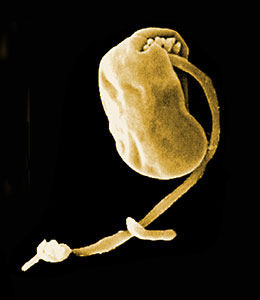Ancyromonas
David J. Patterson- Ancyromonas contorta
- Ancyromonas sigmoides
- Ancyromonas melba
Introduction
Ancyromonas cells are small, less than 10 µm. They glide and have two flagella. The posterior flagellum inserts below the apex of the cell and trails to the rear; the anterior flagellum may be thin or of normal size, and it may sometimes be absent. There is usually a groove from the point of insertion of the posterior flagellum and along the lateral margin of the cell. The cells wobble as they glide.
This genus is widespread and common. It has been reported from marine and terrestrial habitats. The organisms probably consume bacteria. Three species are currently recognised, of which only two (A. sigmoides and A. melba) have been reported recently (Patterson and Simpson, 1986).
On the basis of comparisons of small subunit ribosomal RNA genes, Atkins and co-workers (Atkins et al., 2000) have suggested that Ancyromonas is closely related to the lineage which gave rise to animals and fungi, although sister group relationships have yet to be resolved.
The type species is A. sigmoides Kent 1880.
Characteristics
The genus has been the subject of one ultrastructural study (Mylnikov 1990) under the generic name Heteromita. The genus has mitochondria with flat cristae. The cell surface is supported by materials within and external to the cell membrane. There are 'ball and cone' style extrusomes present. The most similar taxa are Metopion and Caecitellus, but Ancyromonas can be distinguished from both by the site at which the anterior flagellum inserts.
Discussion of Phylogenetic Relationships
Phylogenetic relationships among the species in this genus have not yet been investigated.
References
Atkins, M. S., A. G. McArthur, and A. P. Teske. 2000. Ancyromonadida: a new phylogenetic lineage among the protozoa closely related to the common ancestor of metazoans, fungi and choanoflagellates (Opisthokonta). Journal of Molecular Evolution 51:278-285.
Hänel, K. 1979. Systematik und Ökologie der farblosen Flagellaten des Abwassers. Arch. Protistenkd. 121:73-137.
Mylnikov, A. P. 1990. Characteristic features of the ultrastructure of colourless flagellate Heteromita sp. Tsitologiya 32:567-571. (In Russian)
Patterson D. J. and Simpson, A. G. B. 1996. Heterotrophic flagellates from coastal marine and hypersaline sediments in Western Australia. European Journal of Protistology 32:423-448.
About This Page
David J. Patterson

Marine Biological Laboratory, Woods Hole, Massachusetts, USA
Page copyright © 2009 David J. Patterson
 Page: Tree of Life
Ancyromonas .
Authored by
David J. Patterson.
The TEXT of this page is licensed under the
Creative Commons Attribution License - Version 3.0. Note that images and other media
featured on this page are each governed by their own license, and they may or may not be available
for reuse. Click on an image or a media link to access the media data window, which provides the
relevant licensing information. For the general terms and conditions of ToL material reuse and
redistribution, please see the Tree of Life Copyright
Policies.
Page: Tree of Life
Ancyromonas .
Authored by
David J. Patterson.
The TEXT of this page is licensed under the
Creative Commons Attribution License - Version 3.0. Note that images and other media
featured on this page are each governed by their own license, and they may or may not be available
for reuse. Click on an image or a media link to access the media data window, which provides the
relevant licensing information. For the general terms and conditions of ToL material reuse and
redistribution, please see the Tree of Life Copyright
Policies.
- First online 04 October 2000
Citing this page:
Patterson, David J. 2000. Ancyromonas . Version 04 October 2000. http://tolweb.org/Ancyromonas/2386/2000.10.04 in The Tree of Life Web Project, http://tolweb.org/










 Go to quick links
Go to quick search
Go to navigation for this section of the ToL site
Go to detailed links for the ToL site
Go to quick links
Go to quick search
Go to navigation for this section of the ToL site
Go to detailed links for the ToL site